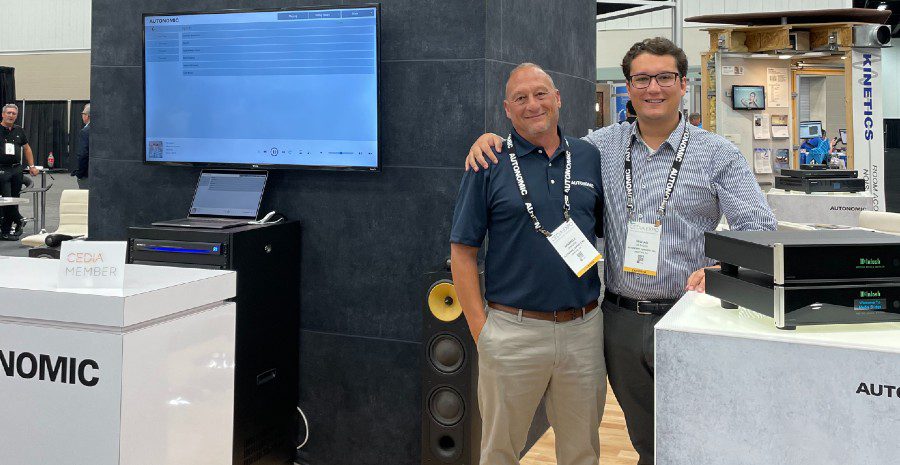CEDIA Expo 2021 marked the “return,” so to speak, of Autonomic to the show in more than just the in-person vs. virtual way.
Attendees at the Indiana Convention Center saw some familiar and familial faces at the Autonomic booth during the Sept. 1-3 CEDIA Expo. Michael de Nigris returned as CEO with Autonomic as an independent entity again following the multiroom audio specialist’s reacquisition from Snap One in May 2020.
And Michael de Nigris Jr. has been taking on a greater role at the Armonk, N.Y.-based company, and engaged in dealer discussions on what Autonomic has been focusing on since the purchase, which followed Snap’s original acquisition in 2016.
“Really, just the opportunity presented itself to become independent again and it made sense from a logistical standpoint, and it’s really great,” says the younger de Nigris, whose official role is product engineer at Autonomic, and chatted with CE Pro during the Expo.
It also made sense for de Nigris Jr. to absorb as much company knowledge from his father to carry on the Autonomic legacy. His education and experience over the past decade have helped accelerate his confidence in taking on more responsibilities.
“I’d say that process is already under way,” he notes. “Day to day, I’m in the office, I’m talking to the development team, I’m answering the phone calls and managing support, finding new hires for the team and kind of looking for what direction the products should go.”
Younger de Nigris Helps Keep Autonomic Solutions Integrator-Friendly
Having been “snuck in” to his first CEDIA Expo a decade ago when he was 17, and working for Autonomic on and off since, de Nigris can appreciate Autonomic’s rich tradition in the custom industry.
“At the time I was working in the warehouse, assembling product and doing returns and repairs, I was working tech support,” he says of his high school experience, before heading to the University of Vermont to study mechanical engineering.

He’s also a big music fan who enjoys 2-channel audio, and after earning his degree de Nigris returned to the metropolitan New York City area and dove into custom integration. He worked for local companies as a field technician doing racks, cutting in architectural speakers, pulling wire and more.
“I absolutely started from the very bottom and ended up working for Audio Video Systems in Plainview, N.Y., and that was a fantastic opportunity because the quality of projects they do is unlike anything I’ve ever seen before,” de Nigris recalls.
Understanding Product Pain Points Influences Autonomic Updates
“It also gave me the opportunity to work with top-of-the-line products in our industry, which is just incredible,” he adds, explaining that after about a year he moved into systems engineering. “So I was doing the CAD drawings, the layouts, the speaker plan … I would design home theaters and all sorts of work there.
“And that, I think, set me up and I couldn’t imagine a better way to position myself to come into Autonomic and have an understanding of the technician, the dealer, the business owner and what it takes to be a successful integrator – and what they need from a product in order to generate that success,” de Nigris says.
He cites common integrator pain points such as product reliability and serviceability, which Autonomic takes into consideration during product development and firmware updates that can improve the experience for both new and existing customers.
Earlier this year, Autonomic announced its new MMS-OS 6.2 operating system toward that end, which had 200+ new features and improvements for its flagship eSeries line, according to the company.
“They need a way to manage their existing installations – Audio Video Systems has over 100 servers out in the field, and they’re able to update the firmware remotely,” de Nigris says. “And we’ve put out some really key firmware updates.”
The company continues to enhance its lineup of mutiroom/multisource servers, streamers, amplifiers and audio accessories with new features, ensuring integration with the smart home systems and popular streaming media services, he says.
“We find that dealers even when they have the ability to use music services built into control systems, they still come back and use our products because of the reliable integration, the consistency when they use multiple control systems that they have the same kind of expectations with whatever they’re installing [the Autonomic product with] and the breadth of services,” de Nigris explains. “Our main focus lately has been on the stability of the product.”








